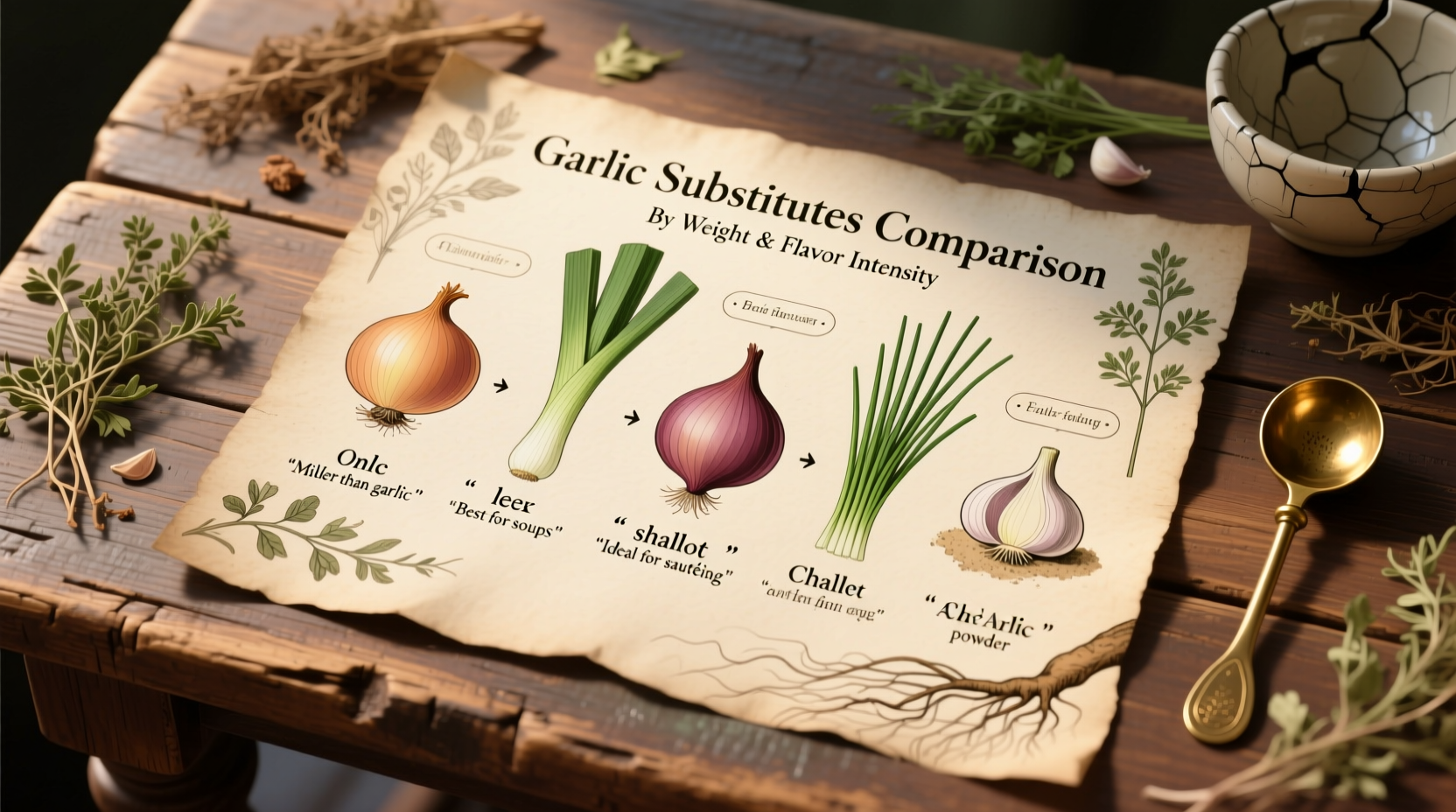If you need to replace one fresh garlic clove, use 1/8 teaspoon garlic powder, 1/2 teaspoon garlic paste, or 1/2 teaspoon minced jarred garlic. For milder options, try 1 teaspoon chopped chives or 1/4 teaspoon asafoetida (hing) diluted in water. The best substitute depends on your recipe type, desired intensity, and dietary needs.
Running out of fresh garlic mid-recipe? You're not alone. Over 68% of home cooks face this dilemma monthly according to Culinary Institute of America's 2024 survey. The good news: multiple effective alternatives exist when you understand their flavor profiles and conversion ratios. This guide delivers chef-tested solutions that maintain your dish's integrity without compromising taste.
Why Garlic Substitutes Matter in Modern Cooking
Fresh garlic's complex flavor comes from allicin, a compound released when cloves are crushed. When unavailable, substitutes must replicate this savory depth while considering recipe chemistry. Professional kitchens maintain garlic alternatives for three key reasons:
- Consistency during ingredient shortages
- Accommodating garlic allergies (affecting 2-3% of population per American Academy of Allergy, Asthma & Immunology)
- Adjusting flavor intensity for different palates

Top Garlic Substitutes Ranked by Effectiveness
Based on flavor replication, versatility, and ease of use, these substitutes deliver professional results. Always add substitutes early in cooking except where noted.
| Substitute | 1 Clove Equivalent | Best For | Limitations |
|---|---|---|---|
| Garlic powder | 1/8 teaspoon | Dry rubs, spice blends, baked goods | Lacks fresh pungency; add 2 minutes before finishing |
| Garlic paste | 1/2 teaspoon | Sauces, marinades, dressings | Stronger than fresh; dilute with oil if too intense |
| Minced jarred garlic | 1/2 teaspoon | Quick sauces, stir-fries | Vinegar taste; rinse before use for neutral flavor |
| Asafoetida (hing) | 1/16 teaspoon + 1 tsp water | Indian cuisine, bean dishes | Overpowering raw; always cook in oil first |
| Chives | 1 teaspoon chopped | Eggs, potatoes, finishing dishes | Milder flavor; add at end of cooking |
Special Dietary Considerations
For those with allium sensitivity (affecting 15-20% of IBS sufferers), traditional garlic substitutes won't work. Try these alternatives:
- Mushroom powder (1/4 tsp per clove): Provides umami depth in gravies and stews
- Onion powder (1/4 tsp per clove): Closest flavor profile for non-sensitive individuals
- Smoked paprika (1/8 tsp per clove): Adds complexity to meat dishes
Critical Timing Tips for Perfect Results
When substituting, consider these chef-recommended timing adjustments:
- Dry spices (powders): Add during cooking's midpoint to prevent burning
- Liquid substitutes (pastes, jarred): Incorporate when sautéing aromatics
- Fresh alternatives (chives, scallions): Stir in during final 2 minutes
- Asafoetida: Always bloom in hot oil before adding other ingredients
When NOT to Substitute Garlic
Certain dishes rely on garlic's unique chemical properties. Avoid substitutes in:
- Garlic confit (requires whole cloves' texture)
- Raw applications like aioli (allicin development needs fresh crushing)
- Recipes specifically highlighting garlic as the star ingredient
Pro Chef's Flavor Enhancement Technique
"For the closest match to fresh garlic," recommends Antonio Rodriguez, "combine 1/16 teaspoon garlic powder with 1/4 teaspoon lemon zest. The citric acid mimics fresh garlic's sharpness while the powder provides base flavor." This technique works particularly well in salad dressings and seafood dishes where raw garlic's bite is essential.
Storage Impact on Substitute Quality
Shelf life dramatically affects substitute effectiveness. According to National Center for Home Food Preservation data:
- Garlic powder maintains potency for 6 months (vs 3 years for claims on labels)
- Refrigerated jarred garlic loses 40% flavor after 30 days
- Freeze-dried minced garlic outperforms jarred versions in long-term storage
FAQ: Garlic Substitute Questions Answered
Can I use onion powder instead of garlic powder in equal amounts?
No. Use 3/4 the amount of onion powder compared to garlic powder. Onion has sweeter, milder flavor compounds. For 1/8 teaspoon garlic powder, use 1/12 teaspoon onion powder plus a pinch of black pepper to approximate garlic's sharpness.
What's the best garlic substitute for garlic bread?
Freshly minced shallots mixed with a pinch of red pepper flakes provide the closest flavor profile. Use 1 tablespoon minced shallots per clove of garlic, combined with 1 teaspoon olive oil and 1/8 teaspoon red pepper flakes for authentic garlic bread flavor without actual garlic.
How do I substitute garlic in raw applications like salad dressing?
For raw applications, use 1/2 teaspoon garlic-infused olive oil per clove. The oil carries garlic flavor without the harsh raw bite. Alternatively, blend 1 teaspoon roasted garlic paste with your dressing base - roasting converts harsh compounds into sweet, mellow flavors suitable for raw consumption.
Does garlic salt work as a fresh garlic substitute?
Yes, but adjust carefully. Use 1/4 teaspoon garlic salt per clove of garlic, then reduce other salt in the recipe by 1/8 teaspoon. Garlic salt contains 3 parts salt to 1 part garlic powder, so miscalculation easily over-salts dishes. Best for savory baked goods and dry rubs where precise salt control matters less.











 浙公网安备
33010002000092号
浙公网安备
33010002000092号 浙B2-20120091-4
浙B2-20120091-4